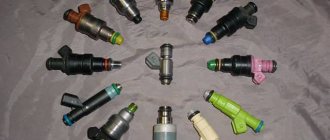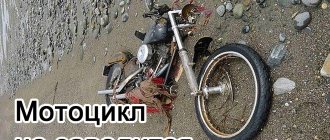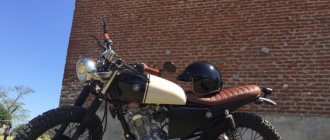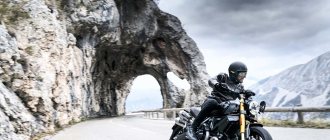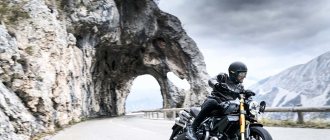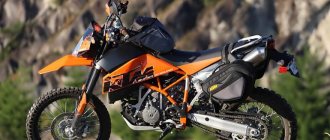A toy for the masses
Five years ago, motorcycles in brutal hooligan style were made to please a small group of consumers. Now both young and old are switching to them. In this spirit, Yamaha released an amazing device.
History sometimes writes out ornate plots. The life of this or that model turns out to be strangely long or, conversely, amazingly short. For example, was it possible in the 80s of the last century to assume that the uncouth externally and unbridled internally Yamaha V-Max would become almost a cult model? In America and Europe, the car gained millions of fans, who, like the characters in the equally popular film “Mad Max,” raced the V-Max along suburban highways and highways, terrifying local residents.
Yes, exactly 22 years ago, in 1984, the first V-Max was released. His concept of “naked power” was extremely suitable: a 140-horsepower 4-cylinder V-shaped engine of 1200 cc, provocative appearance, outstanding performance... Then not a single motorcycle (let alone a neoclassic) could boast of acceleration up to “ hundreds" in 3 seconds and a "maximum speed" of 235 km/h. The device became the personification of rebellion, a symbol of love of freedom for the motorcycle fraternity. It also became a symbol of longevity for manufacturers - none of the famous models lived on the assembly line for such a long time. In addition, the successor to the V-Max will only be made in 2009, that is, a quarter of a century after the start of production of the first model, and, it seems, this figure will be unsurpassed for a very long time.
Yamaha has let the genie out of the bottle. And this ancient old man captured the minds of not only radical youth, but also their parents. Back in the late 90s, a survey showed that more than 30% of motorcyclists would like to keep such devices in their “stables”. And not for weekend trips, but for everyday use. The only “but” is that it scared many people, and many did not need such high power. Style is the main thing. Yamaha designers began to work in this direction. After all, only the V-Max in all its splendor represented this class then.
The first result of this work was shown at the end of 1999 at the Tokyo Motor Show. The creators of the MT-01 prototype immediately placed all the ideological accents and called it nothing less than Torque Sports Roadster. Anyway, long live torque! The power unit is in the industrial style, the chassis is like on a sportbike, the engine is from a multi-cc cruiser... So, this means what kind of replacement is being prepared for the V-Max! It turned out not. Based on this concept, a series of “Max-shaped” motorcycles were released, but the “filling” is completely different – kinder and fluffier.
The game went downhill. If the serial MT-01 was equipped with a 1700 cc V-twin engine like the V-Max, then the next representative of this series, the BT1100 Bulldog muscle bike, already sported an 1100 cc engine. True adherents of V-Max only curled their lips contemptuously at the sight of these “goons,” but everyone else welcomed the newcomers warmly. Very quickly their sales volume in Europe exceeded the V-Max records. The ice has broken, people began to switch to brutal bikes of the new generation.
In 2002, Yamaha conducted another survey among American and European dealers on the topic “V-Max of the future.” Its results are shocking: about 40% of respondents did not want the V-Max to be discontinued, but the same number of respondents said that they would like to see a model similar to the Max, but with a small-capacity engine and a budget price. What can I say? A real split in the ranks!
In fact, the result of such research was the display of the futuristic MT-03 in Milan in 2003. LED optics, a sophisticated chassis, “industrial” finish and... a dead single-cylinder 660 cc engine. No one thought then that this concept, which is essentially a descendant of the V-Max, would survive to serial production.
As is often the case with Japanese manufacturers, Yamaha chose a win-win scenario. The motorcycle was addressed primarily to the European market, and the development of the style was entrusted to local designers - the concept was completely executed by the masters of the Spanish Yamaha studio. That is why the model turned out to be “industrial” and purely European features were introduced into its appearance, such as diode lighting technology and polished aluminum casting brackets. However, when launching the series, the developers took into account the price factor, which is important for Europe, and abandoned some expensive components (the same diodes, for example). But otherwise, and here we must pay tribute to the designers, the production MT-03 is no different from the prototype. However, this trend is no longer an exception to the rule, but rather the opposite.
It is unlikely that this appearance can leave anyone indifferent. Moreover, the pop elements that complement the brutal style (without this combination the model could have remained insufficiently in demand) look restrained and non-trivial. To be honest, I don’t want to drive the MT-03, but I want to look at it and delve into the details of the power circuit. Charismatic toy? Maybe, but not for kids, but for adults who didn’t finish playing with construction sets as children.
Yes, brutality and pop are in harmony here. Where there could be chrome trim (for example, in the radiator trim), there are banal plastic inserts. But instead of the usual lines of the rear swingarm, we see a powerful frame of aluminum casting, and instead of twin rear backpack shock absorbers, as on the V-Max, we see a cleverly laid monoshock with a yellow adjustable spring on the right side. Or take tank pads. Nothing more than a reference to the almost forgotten nigrips (the same rubber bands that decorated the gas tanks of even “sovietcycles”). What about the headlight brackets? A tuner's dream!
It would seem that all these are little things, but without them the MT-03 would have been an ordinary Japanese motorcycle, but it turned out to be an extraordinary device, which you wouldn’t be ashamed to drive up to a social reception. Once the initial noise of your arrival has died down, you can stir up the excitement by dismounting and thus showing off the motorcycle seat. How do you like the saddle upholstery? In two tones, and made of nubuck, and even with contrasting stitching!
And although the LED headlight remains in the memories of the concept, the serial diamond-shaped faceted optics also do not look cheap. The black trim on top harmonizes perfectly with the powerful brackets, which in turn live in harmony with the powerful front fork stays (the fork is the same as the much more powerful Fazer 600) and the black fender. It’s just a pity that the model’s brakes are more than traditional (from the Fazer 600). The wheels just beg for radial designs.
In the photo, the MT-03 seems somewhat pot-bellied - this is due to the bloated shape of the gas tank and the trimmed lower engine part. In fact, the device turned out to be quite compact. Judge for yourself: the base is 1420 mm, the height of the seat is 805 mm, and the width of the widely spaced mirrors is 860 mm. In fact, the dimensions of an urban enduro are narrow and all-climbable. Actually, that’s what the developers of MT-03 wanted.
In traffic-clogged Europe, the element of practicality is placed just above the appearance. And the MT-03 offers a wide seat for both driver and passenger, a minimal level of vibration, a fairly soft suspension, and a comfortable wide steering wheel, which is located quite close to the driver. The result is a comfortable seating position and easy handling of a not-so-light motorcycle. If only you knew how he writes trajectories! How confidently and predictably it slows down! How it shifts in a turn! Just a fairy tale!
The 660 cc “single-barrel” Minarelli/Yamaha, which is equipped with the car, was tested in the XT660 urban enduro chassis. The power unit is proven, reliable and unpretentious - it is not surprising that it has become the main contender for the role of the “heart” of the MT-03. The engine was slightly derated, but at the same time the torque curve was smoothed out, so that it became truly “torque”. Now the engine pulls from the lowest speeds and in the medium zone (5300 rpm) shows a maximum of 56 Nm. 45 forces - at first glance, not so much for 175 kg of dry weight. But don’t forget that this model is not for conquering free space in the shortest possible time, but for confidently clearing urban congestion. There is plenty of power to solve such problems, and those who still lack it should pay attention to the mentioned MT-01.
Bright appearance, pilot-friendly ergonomics, good handling, moderately powerful engine... This set of qualities will appeal to the average man in the street, “majors” and beginners - as already mentioned, the MT-03 was initially aimed at approximately this consumer group. These people will not practice “candles” and “stops” somewhere on the track. They just want to move around the city, to work and back, and at the same time enjoy the fact that they are sitting on such a beauty. Needless to say, it will be nice to admire it when you go out to the parking lot after a working day. Or just looking out the window from time to time. Things should make us happy! By the way, some call this kind of motorcycle equipment for women, but the term “unisex” seems more appropriate to me. She will not leave anyone indifferent.
It must be said that for Yamaha, which poured a lot of money into this project, it would be an unaffordable luxury to somehow narrow the circle of MT-03 users. After all, in fact, the concept of the model is universal, and only the “filling” of the device limits the scope of its application. So it was decided, along with the main MT-03, to release a couple more interesting modifications. We are talking about Spider Smart City and Cafe Motard.
In fact, these are versions tuned to the maximum. They say, look at what an ordinary MT-03 can turn into if you put your hands to it and show some ingenuity. Cafe Motard – for extreme sports enthusiasts and those who felt super motard potencies in MT. They will like the more aggressive look of the car. Chopped plastic, spoiler protection under the engine, sharp beak of the head wing, blackened body elements. The upside-down fork, brakes with “star” discs and wheels were borrowed from the latest, most sophisticated YZF-R1 SP sportbike. Agree, it’s a good set! The place of the heavy “double-barrel” muffler was taken by a lonely tuning “end”, placed under the “tail” with an LED stopper. Visually, the “body kit” made the front part heavier (it looks like a sprinter frozen at the start), and the rear, on the contrary, became visually lighter and taller. The trick is a bracket for the license plate on the pendulum. The “tidy” is tiny, obviously of scooter origin. Other bells and whistles include a “starting number” perched on the left side of the plastic that replaced the passenger seat. Even in static conditions, the model looks menacing and charged, as if it had just skated in a supermoto championship.
MT-03 Spider Smart City is a different fruit, tasty and ripe. There is no aggression at all, but there is more than enough tchotchkes designed to increase the pilot’s comfort. Let's start with the fact that the plastic on this modification is mother-of-pearl, the saddle is covered with expensive and practical Alcantara. There is already a windshield of a very original look - not only is it embossed and bends around the headlight, it also has a beautiful “chameleon” tint. There are also... side cases, for a car of this class - this is nonsense. And besides, they look extremely aerodynamic. So goodbye, urban jungle, welcome to the highway, to the long distance!
All this is offered in stock. Well, if you have an appetite while eating, then you are welcome to the expanded menu, where you can find a lot of useful things for all three versions of the MT-03. For example, hand protection on the steering wheel in the Endur style, an impressive cover on the passenger seat (to emphasize sportiness), mufflers from the famous Akrapovic. By the way, the latter will be able to return the “five” “horses” stolen during depowering: 50 hp. for MT-03 this is possible.
It is also worth mentioning that the list of additional equipment is enriched with a large number of clothes and accessories in the same style. And the price of the model in Europe is very attractive - for the MT-03 they ask €6500 (versus €7800 for the Fazer 600). Based on all that has been said, it is easy to assume that in the near future the new MT series will become very popular on the European market.
In our country, unfortunately, the situation promises to be completely different. Despite the centralized (under the leadership of the Japanese from the Russian representative office of Yamaha) dealer policy, for some reason such products are promoted to another level. The logic is simple: everything that is new and unusual should cost more. Therefore, the price for the MT-03 will be much higher than for the already sore 600 cc 100 hp Fazer. And if we also take into account our specific mentality (the more powerful, the cooler), then the fate of the MT-03 in Russia is painted completely in black. It's a pity, it turned out to be a beautiful motorcycle.
Mikhail Lapshin:
https://www.motor.ru/archive/number121/art22
For whom the drums beat
Testride of the new Yamaha MT-03 roadster
“Kodo”... Those who read my test of the debut Yamaha MT-01, a stylish bike with a maxi-twin, should have remembered this word.* I characterized its spirit with that same Japanese word - it emotionally conveys the beating of the human heart. And in a figurative sense it means the beating of ritual Japanese drums. In ancient times, they were used to announce the invasion of ninja warriors into the emperor's court... Today, “kodo” refers to a piercing, thunderous sound escaping from the mufflers of the MT-01. Now the double muffler under the seat of the new Yamaha MT-03 single produces an equally deep drumbeat.
The ancient drums sounded their alarm bells equally alarmingly, regardless of whether the attackers were giants or the power and skill of the warriors were disguised under a deceptive appearance. And this is fair, because a skilled little ninja is no less dangerous. When he rushes at a victim, he is most often able to use his body better, more efficiently, his blow with a sword can be stronger than the blow of a portly, but not so agile and dexterous fighter. I can say about the same to the MT-03, which is inferior to it in this property. I'm not talking about belligerence, but about the ability to deliver what motorcycles of this class are now most often purchased for - to provide riding pleasure. I felt this when I rode it along the picturesque rocky coast of the Costa Brava in Spain. Here is the most famous site where the qualifying battles of the world automobile championship "Rally Catalunya" take place. By motorcycle standards, this is perhaps the steepest track in Europe - with many zigzag turns. Over the many years of testing the equipment, I had the opportunity to ride on it fifty times on different motorcycles, starting with a Yamaha R1 and ending with a Honda Transalp. But never before have I driven it so quickly and with such excitement as on the latest 1-cylinder addition to the MT family. Yamaha dubbed it a “motard roadster” and put it into production at the company’s Italian plant, north of Milan. This year, 8,000 pieces of equipment will be assembled here.
Over the 50 years of its existence, the Yamaha motorcycle division has proven itself to be the most inventive Japanese manufacturer. Remember: R1, R6, DT-1, XT500, TDM, T-Max, V-Max, SR500, WR400, RD250/350LC* Can you list them all? Two years ago, the company recognized the growing wave of the Supermoto subculture. And they responded immediately: they immediately presented the street single XT660X - a road version of the XT660R with a new 4-valve engine (assembled in Bologna by designers of the Italian subsidiary of Yamaha - Minarelli). Although the XT-X is a solid vehicle, it didn’t make much of an impression on the road—in fact, it turned out to be a simplified Supermoto. Intelligently designed and practical, it was inferior to its Austrian and Italian-made competitors in terms of technical characteristics and that undeniably important quality called “liveness.” Apparently, this is all due to traditional differences between Japanese and European perceptions of the product. Reliable and stable, it resembled the two-wheeled equivalent of a Suzuki Vitara - stylish on the outside but empty at heart. It's a pity.
But the European branch of Yamaha had already prepared another solution: at the Milan exhibition in 2003, together with the XT-X, they presented the MT-03 concept bike. He looked radical, the public liked him! It was created in the design studio GK Design (GKDE), the same one that presented the MT-01 concept bike at an exhibition in Tokyo in 1999. “We had to work hard to create an extreme, knocked down design,” said company specialist Michael Ularik. — MT-01 was conceived as a very rough, deliberately primitive-looking motorcycle, made as if from a single piece of iron. The MT-03 is completely different: it was conceived, I would say, with a sophisticated design: it is a relevant urban product.” When it was launched into production, the designers conscientiously preserved all the details of its predecessor or made minimal adjustments - they brought only the essence within the framework of the new concept. The only significant change is this: the Ohlins rear shock absorber of the prototype was replaced with a cheaper Sachs, but retained the innovative - direct upper connection to the swingarm, without a progressive linkage system. The designers created a bike with concentrated mass, and this, it is not difficult to understand, improved the quality of handling on the move . Its 52/48% weight distribution provided better cornering grip from the front tire (120/70-17 Dunlop D270). With a dry sump engine, the 3.2-liter cast oil tank is pushed forward and located just below center in front of the engine. Not only does this arrangement improve handling, but it also creates a unique appearance: the MT-03 looks like a “knocked-down” boxer with a powerful torso and a thick, flattened “nose.” I'm sure the ninjas had the same noses. I looked at the MT-03 in its black attire (it seemed to be “made” by the same fashion designer who “dressed” the Stealth bomber), and even the generous Spanish sun could not add cheerfulness to its appearance. Blue and white models are also available for the same 6,990 euros. But why not silver?!
Having sat down on the seat (805 mm in height), I involuntarily leaned forward: this driver’s position corresponds to the appearance of the bike. But the straight handlebars and short, small gas tank (its capacity is 15 liters) forced me to straighten up and sit like Supermoto racers. I didn’t expect it, but even with my height it will be comfortable to drive the entire 160 kilometers along the Costa Brava. The footpegs are set high enough to avoid scraping them on the asphalt when cornering. The ground clearance is, I would say, limitless: the boots are more likely to touch the ground than the Yamaha. Since the seat is moved forward, it is easy to use your weight to optimize mass distribution as much as possible. The flat headlight is topped by an incredibly compact instrument panel, but it contains almost everything you need: an analog tachometer and a small, elongated LCD screen that displays speed, total mileage, dual trip odometer and clock. I didn't find the temperature sensor. Strange for a motorcycle with a liquid-cooled engine.
The MT-03 has the same 5-speed, 660cc, 4-valve, liquid-cooled, fuel-injected engine as the XT660. The same, by the way, on the latest version of Aprilia Pegaso. This road version is, to my surprise, a less radical solution to the street single-coil sector than the unique Yamaha. Thanks to the catalyst located in the only muffler under the seat (a clever stylistic idea: there are two mufflers, and both have covers that protect the passenger’s legs), the motorcycle “meets the requirements” of Euro 2 for noise and emissions. In the future, Yamaha designers assured, the exhaust will be easy to “clean” to more stringent Euro-3 standards (they will come into force in 2007). I think that “additional cleaning” was not introduced right away because it did not “impair” its technical characteristics - they want to stun buyers while there is time with maximum torque figures. And there should be enough time: the model will go on sale now, at the beginning of the season. And now I’ll try to surprise you - just as I was surprised. There's a large 5.9-liter air filter housing and a retuned Nippondenso single-injector electronic fuel injection system. The engine produces 45 hp. on the shaft at 6000 rpm. Engine dimensions 100 x 84 mm, gas distribution by one camshaft with a chain drive. No, there is nothing strange about this. What’s surprising is that it develops 3 hp. less than the same motor on the XT660X (and also 5 hp less than the Pegaso!). And there is 3% less torque - 56.2 Nm at 5250 rpm (5% lower than Aprilia). Some R1 owner has twice as much at his disposal already at idle. But for some motorcycles, and especially for the MT-03, it is not so much the potential that is important, but how you use it. And then, a less powerful bike has much more potential on the road (not to be confused with the track!) than any of its comparable rivals. Let me be clearer: for dashing rides along the Costa Brava, I would take the MT-03, not the R1. When creating this model, the key goal was to reduce the overall gear ratio, for which two more teeth were added to the rear sprocket. Which significantly increased acceleration at any speed. True, we had to sacrifice the “maximum speed”. That’s why, when the tachometer needle reached 7000 rpm, I was able to achieve only 185 km/h on a straight line (the speed was measured using an external device - at 164 km/h the standard digital speedometer went into the red zone). So what about Togo? People don't buy a street rod to cruise along the highway from Paris to Rome. The MT-03 showed itself to be a great performer on its “home field” - its native Catalunya circuit. Yes, on the dyno the MT-03 shows lower power and torque values than its competitors, but it has a wider range of both. This means better technical characteristics on the road, and this is where it plays the most important role for this type of device. It “runs” the same throughout the entire range, up to 6000 rpm (140 km/h) for as long and as fast as the pilot wants and can.
Source: MOTO Magazine
